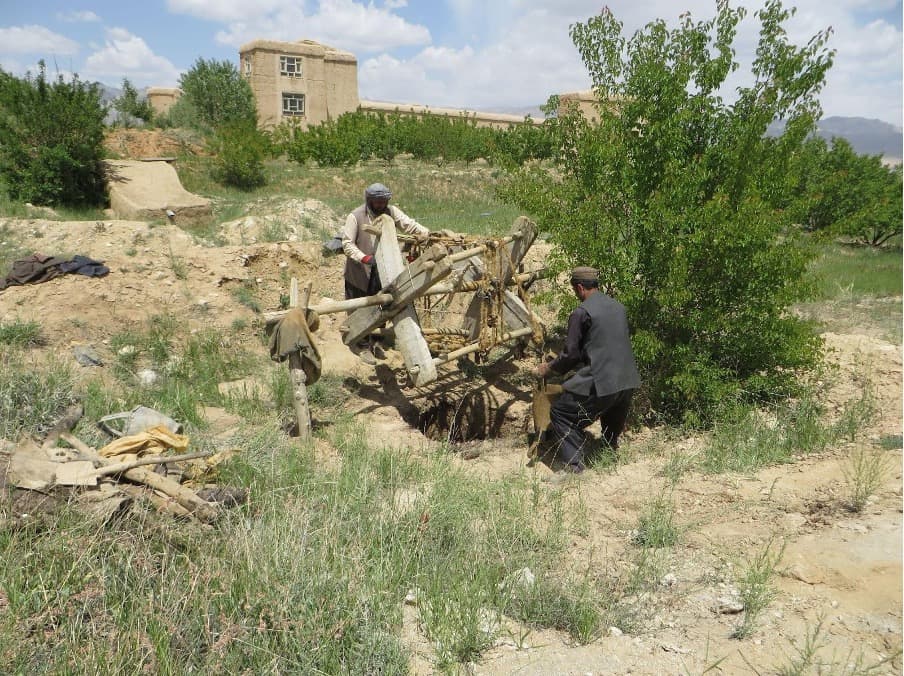

Aerial view of a karez, in Iran – No Source, All rights reserved
Feda Wardak, Two craftsmen digging a karez, district of Jeghatu, Afghanistan, 2015, photo credit: Feda Warda, Courtesy of the artist
Created in 2021, Paris, France
Feda Wardak
Born Peshawar, Pakistan (1991), lives and works in Paris, France
Skies, grounds and undergrounds 2024
steel, wood, plaster
10m x 6m x 17m
Courtesy of the artist
The production of this work was supported by IFN / Embassy of France in Nigeria and by the Alliance Française, Lagos.
Commissioned & supported by Lagos Biennial 2024
Artist’s statement
Skies, grounds and undergrounds is an immersive installation that exposes the impact of drone strikes ordered by the US Air Force in Afghanistan, as well as the Afghan struggles that respond to them from the underground. Over the past twenty years, US imperialist dynamics have relied on vantage points in the sky to bomb Afghanistan. At the same time, for almost two thousand years, Afghan farmers have been digging up the soil to collect water. These different spaces have been brought into tension.
While the international coalition had control of the sky, the Afghan resistance organized itself from the underground. They used the karez originally designed as a water management system; this millennia-old infrastructure was reappropriated by resistance fighters to move men and equipment underground, remaining invisible to eyes above. A new kind of invisible urban planning began to take shape below the visible urban planning on the ground. The art piece is designed around a path that allows visitors to move through these different points of view; from the underground to the ground and up into the sky. This shifting point of view brings the US imperialist and extractivist logics into contrast with Afghan resistance (focused on repairing ancient waterways).
Two thousand years ago, in the middle of Afghan drylands, farmers built karez. These underground tunnels, several kilometers long, capture water from the water tables beneath the mountains and carry it to the arid valleys to irrigate the land. On the surface, vertical wells are dug all along the karez to remove soil and provide access to water.
For the past fifty years, Afghanistan’s tribal regions have suffered the effects of various, often overlapping conflicts. The military forces of the Soviet Union and the United States, as well as NATO forces, successively pursued policies of near-incessant bombing to force local populations into exile, intending to cut off support to local resistance networks by means of physical displacement. Beginning in the 1980s, the Afghan mujahideen (resistance fighters) worked to connect individual karez systems with one another, creating a vast network of underground tunnels that would prove an invaluable tool for local resistance. By reappropriating this architectural infrastructure, combatants gained access to a city beneath the city, thereby becoming invisible. Through its role as a subterranean refuge, the karez network became a vital platform for urban guerrilla warfare, acting as a space for activities as diverse as schooling and medical care to grain storage and postal distribution.
In 2001, the United States invaded Afghanistan. The following year, the US Army began hosting video game competitions in Nevada, with the aim of recruiting talented players. Many of whom were minors and were trained to become drone pilots. Sitting in containers in the middle of the American desert, they fly one-handed over Afghanistan using a joystick, and with a single click can bomb any area.
Various studies carried out by war psychologists show that the further away we are from the victims, the greater our capacity to act violently against them. Distance creates indifference. It’s important to point out that the notion of distance can be expressed in different ways. Firstly, it is physical and geographical, because without a front line, there is a distance between an action produced somewhere and its consequences elsewhere. This distance is also technological: there is an omniscient protagonist who attacks from above, and a protagonist who suffers without being warned. Finally, we could also talk about an ethical distance, because we can no longer see the enemy, he no longer has a face, which means that the notion of empathy no longer exists. The body no longer has a human representation; it becomes a spot on the screen.
In war contexts, the imperialist narrative often becomes the dominant one.
By presenting a single event across multiple perspectives through parallel viewpoints at different heights, the installation allows the visitor to consider the experience below-ground, at ground level, and from above. In highlighting this aspect of the Afghan resistance, the invisible is made visible, allowing these counter-narratives to claim existence.
HANGING IMAGINARIES’ work is included in REFUGE teams.








